
Mindful Nutrition for a Fussy Eater
As a parent, it’s normal to worry about whether your child is getting enough of…

As a parent, it’s normal to worry about whether your child is getting enough of the right kinds of foods. Children may be distracted at meals or resistant to trying new things. We are here to be your partner to help you achieve a balanced life for you and your child.
As a parent, it’s normal to worry about whether your child is getting enough of the right kinds of foods. Children may be distracted at meals or resistant to trying new things. Why does everything taste icky?
Mealtimes can be a daily struggle and change takes time while you explore tactics to optimise nutrition for your child’s neurodevelopment. Foods fuel our bodies and feed our souls. We are here to be your partner to help you achieve a balanced life for you and your child.
Children with ADHD and neurodiverse conditions especially often have unique challenges when it comes to health and nutrition:
Children with neurodiverse conditions are more prone to developing emotional and health issues related to foods as they get older.
But there is good news for parents. By guiding your child to learn mindful eating practices, they can be more present and calmer at mealtimes. They can become more open to trying new foods and learn to make intentional and healthier food choices.1-3
It’s not always easy to prepare healthy meals for your family consistently. We recognise that you have many demands and many commitments, and you probably feel that you are “on the run” most of the time. You may look at this as yet another item on your “to-do” list. We invite you to simply look at it as an overall “checklist” and gradually make changes until you feel you have a successful routine.

Children with low food intake can develop nutritional deficiencies impacting learning, behaviour, and overall growth and development.4
Additionally, decades of research show a strong correlation between ADHD, unhealthy eating, and obesity. The connection is so strong, in fact, that someone with ADHD is four times more likely to become obese than someone without ADHD.5-7
There is no one-size-fits-all solution for neurodiverse children regarding health and nutrition. These resources offer a variety of options to help parents/caregivers create personalised solutions for the unique needs of their children.
As a registered dietitian, mum, and neurodiversity advocate, I am honoured to be able to bring this resource to you. A very special thank you to the healthcare professionals that have contributed their valuable time and remarkable content.
Tricia Griffin, RDN, LD
Does your young child turn up their nose at just about every meal you offer them?
“Why won’t you eat it?” says Mum. “I don’t like it; I’m not hungry,” says the child, as they toss it in the air. This is a very common situation.
Picky eating is common in younger children, but most outgrow the habit and learn to like a broader range of foods. Research shows that many picky eaters have parents/ caregivers who are picky eaters, suggesting both genetic and environmental contributors. Lack of experience early on with various tastes, textures, and smells can lead to picky eating later in life.12
Losing appetite is especially common with children with neurodiverse conditions — and for good reasons. There are several links between neurodiverse conditions and picky eating: 8-10
Studies show many children with attention-deficit / hyperactivity disorder (ADHD) have low levels of dopamine activity in their brain and they are chemically wired to seek more.11
Dopamine is the brain chemical responsible for feelings of pleasure and reward. Sugar is one food that delivers a surge of dopamine to the brain. As such, many with ADHD or ADD are likely to crave sugar. A child may push away nutritious foods like vegetables or protein because these do not deliver the sugar and dopamine rush that the ADHD brain craves.
Children with neurodiverse conditions may also exhibit sensory defensiveness, which is more than “picky eating.”
A particular taste, smell, texture, temperature, or food colour can make these children feel like the sensory experience is “hurting” them. The experience can be so overwhelming that they are repulsed, panicked, or sickened by exposure to it.13
When your child says that something doesn’t taste “right” or “good,” he may be telling the truth. We are all wired differently in what appeals to our senses and palate. It may be that picky eaters represent a population of children who are hypersensitive to certain aspects of eating.
Picky eaters dislike a variety of foods, much like the sensory eater. However, when picky eaters try new foods, it doesn’t cause a sensory overload.
Sensory overload can come in a few different forms for children with ADHD. There is a sensitivity to textures, where children can only handle one texture, such as smooth, pureed foods. In this case, they might be able to eat yogurt. However, hand them a bag of chips or a slice of turkey, and they immediately begin to gag. This is one of the most common sensory eating issues.
.jpg)
There are also sensitivities to favour and smell. If a child has a sensitivity, they can experience a meltdown and break out into a cold sweat because a piece of candy was “too sugary”, or a cracker was “too spicy.”
A child might choose not to eat at all to avoid physical or mental pain associated with the food.14
Feeding guidance may need to be different for picky eaters versus sensory eaters.
For example:
“They get what the family is getting. Eventually, they will be hungry enough to eat.” This feeding strategy may not be effective for sensory eaters. If they see food as causing pain, it doesn’t matter how hungry they are. They’ll refuse the food to avoid the pain.
Unfortunately, as time goes on, more negative behaviours may develop. Your child might begin to fear more foods or mealtimes in general, even if you serve foods that might not “hurt” them. As they begin to associate eating a wider range of foods with a negative experience, they might often refuse to eat.12
All children experience eating jags, where they ask for one food all the time and then they don’t want it. Picky eaters will return to that food again after a while, so their food repertoire expands over time. Some sensory eaters may never eat the food again, so they slowly whittle away at acceptable foods until the list includes less than 10 or 20 foods.
Picky eaters don’t mind if they don’t have to eat that food. Sensory eaters will gag or even vomit just watching others eat food they don’t like. Sometimes this behaviour comes from forcing a child to eat food they don’t want.
A picky eater can tolerate new foods on a plate—even if reluctantly. A sensory eater “falls apart” when presented with new foods and refuses to eat.
Laura Russin, a speech pathologist, and mother of two, offers her expert suggestions for dealing with sensory sensitivities and picky eaters and shares tips on introducing new foods to your child with sensory sensitivities in a supportive way:14

I cannot stress these key points enough — no pressure and go slowly! Remember, our children are not just picky eaters.
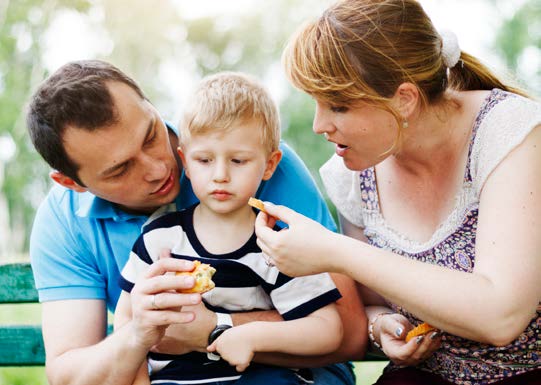
Feeding therapists often use food chaining to expose children to new foods and increase variety. Simply put, food chaining builds bridges to foods you really want your child to eat by linking new foods to foods they’re already eating.16
With food chaining, you:
Here’s an example of how you might transition from eating only chicken nuggets to baked fish filet to increase protein variety:
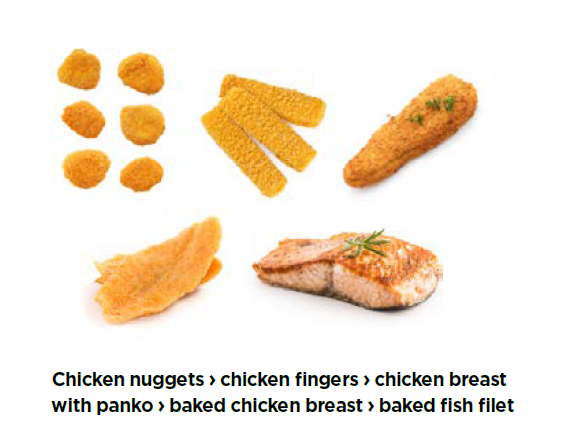
Or from potato chips to trying frozen bananas:
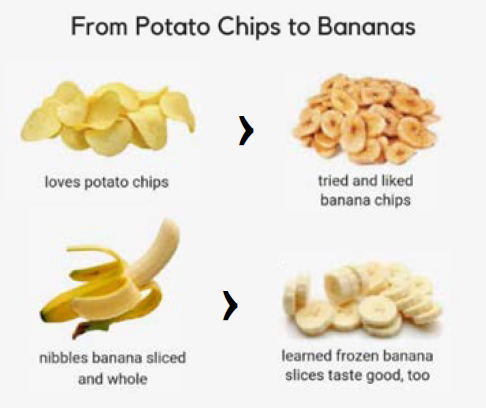
When exposing a child to new foods, ask them about foods they would feel least anxious eating and create a hierarchy with their input. Don’t be afraid to mask flavours with dips and sauces, slowly reducing those as acceptability increases.
Another strategy is to add foods they avoid to the foods they will eat to make gradual colour, texture, or flavour changes. For example, add bell peppers or broccoli to tomato sauce. If your child loves fruit, whip up a healthy smoothie with berries and plain yogurt—and throw a few spinach leaves into the blender.
Every child is different, and what has worked for you, or your other children may not work for every child.
Lisa Kandell Kotler, MS RDN CSP, Certified Specialist in Paediatric Nutrition shares, “One of the biggest challenges I see is parents/caregivers projecting their image onto their child. It is natural to use your own experiences and preferences and project it to them, but this may not be what your child wants, needs, or can even handle.”
She recommends being present, observing, and listening to your children. That is easiest to do when you’re present at mealtimes.
Eating mindfully helps children develop a deeper connection with food to create lifelong, healthy habits. It encourages children to focus on the present — noticing thoughts, feelings, and physical sensations associated with foods and eating.
This helps children to:
Being mindful means taking time and getting in touch with the taste, texture, and flavours of food. It also involves savouring the eating experience, rather than doing it automatically. And while this practice may seem unnecessary, it has plenty of benefits for children.
These include:
It can also help kids incorporate healthier foods into their diet, providing nutrients needed for growth and development.

Mindful eating is just one form of mindfulness. It can be applied to different situations throughout the day and encourages children to reflect and be more aware. Mindfulness supports the development of critical skills such as focus, concentration, and self-regulation. Giving children an opportunity to appreciate the beauty of a given moment helps build resiliency and puts them in tune with their own emotions.
Encourage them to Sit down while they eat. Limit distractions by putting away or turning off cell phones, computers, and television.
Slow down.
Savour their food.
Lay the groundwork and help your child understand what it means to practice mindfulness. Explain why developing a deeper appreciation for food is essential, while also branching out and trying something new.
Encourage children to use all their senses and practice small mindful bites using all their senses. Once they have a general understanding of practicing mindfulness, encourage them to experience their food in a new way.
Talk about the mind-body connection. All foods carry essential nutrients that support our growth and keep us healthy and strong. Nutritious food influences how we feel, including our energy levels throughout the day. Invite your child to dive deeper and think about where their food comes from, the nutrients it contains, and what fuels them the most to play and learn. Also, help them recognize when their bellies feel full or when hunger has queued the “low fuel” signal.
Make mindful eating a food adventure that helps guide your child through their experience. As you are eating ask your child about their experience:
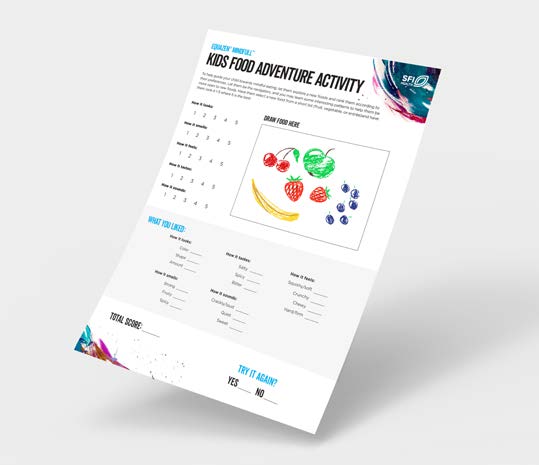
There is a fine line between being too controlling and over-permissive. Parents and caregivers who are too controlling about their children’s food choices tend to have children who do not have healthy eating patterns. On the other hand, parents/caregivers who don’t pay enough attention to their children’s eating patterns also tend to have children who do not make healthy choices.
The goal during childhood is to meet nutrient needs and promote a positive relationship with food and nutrition. That way, as children transition into adolescence and begin to make their own choices, they tend to make wiser decisions.17

Ellyn Satter, a registered dietitian, and authority on children’s eating and feeding encourages a division of responsibility among parents/ caregivers and children regarding mealtimes. This helps children develop eating competence and become self-directed with eating.
Parents are responsible for the “what, when, and where”; what food is available, when it is offered, and where it is consumed.
Children are responsible for choosing which food they eat from what is offered, how much is eaten, and whether they eat it or not.
If parents/caregivers use a positive approach and practice mindful feeding, children tend to practice mindful eating.18
| Parent’s Responsibility is to: | Child’s Responsibility is to: |
| Choose and prepare the food | Choose to eat |
| Provide the opportunity for the child to choose healthful foods at meals and snacks | Choose from what is offered |
| Provide positive teaching moments related to food and nutrition | Choose how much is eaten |
| Lead by example Be considerate of the child’s inexperience with foods Do not bribe children to eat Trust children to choose the correct amounts of healthful foods when given the opportunity | Come to the table and be positive about the food that is offered, even if they choose not to eat most of the meal. This approach can help foster good eating habits and mealtime behaviour. |
This combination tends to sustain energy, focus, alertness, and attention.
Protein increases the ability to stay alert and focused by raising dopamine (a feel-good chemical) in the brain.
Whole grains and complex carbs may be “calming” and “soothing” because they help raise serotonin (another feel-good chemical) in the brain.
Healthy fats provide essential fatty acids essential for brain development and function.
Eating too many sugary foods or refined (white) starches causes a sharp spike followed by a drop in blood sugar. Skipping meals or having a gap of more than four hours between meals or snacks may lead to low blood sugar levels. Both contribute to that “hangry” feeling.
However, eating a mixture of protein, carbs, and fat every three hours or so helps stabilize blood sugar. That reduces hunger, irritability, and potentially undesirable behaviour while improving concentration and focus. Try to plan ahead and send your children to school, activities, or play dates with healthy snacks to bridge the gap between meals.
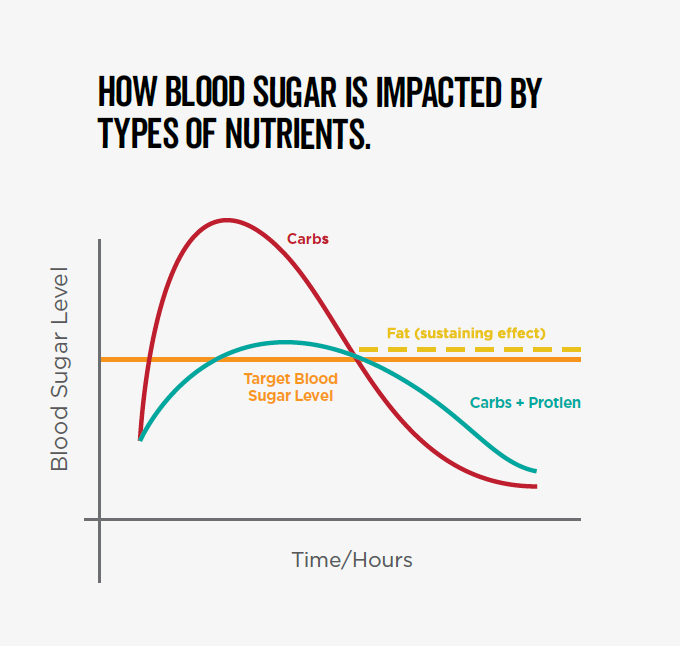
Use the Green-Yellow-Red light food system when planning meals and snacks.
Green light foods are the most healthful, nutrient-dense foods. These are delicious, nutrient-packed, whole foods that children are encouraged to eat frequently.
Yellow light foods are less nutritious than green light foods. They might be high in calories and have more sugar, salt, unhealthy fats, or other additives.
Red light foods are “once in a while” foods you want to stop and think twice about before eating. Try to shift more of these to yellow and green light options.
Please use this list as a guide to promote more variety in your child’s diet. We encourage you to provide balanced meals that contain a mix of green light carbohydrates, protein, and fat.
This may help balance your child’s blood sugar and provide their brain with the fuel needed to help them stay alert and focused.
| Green Light Foods (Eat these often) | Yellow Light Foods (Eat these less often) | Red Light Foods (Save these for occasional treats) | |
| DAIRY OR DAIRY SUBSTITUTE | ● Cow, goat, or plant milk (unsweetened) ● Cottage cheese ● Plain Greek yogurt ● Kefir (unsweetened) ● Regular or dairy-free cheese | ● Sweetened Greek yogurt (without artificial colour) Tip: Make flavoured yogurt by adding mashed fresh or frozen fruit, or cocoa powder and a drizzle of honey to plain Greek yogurt. | ● Sweetened, flavoured milk ● Ice cream or frozen yogurt ● Pudding |
| PROTEIN | ● Beef or pork ● Chicken or turkey ● Fish or seafood ● Legumes/dried beans such as kidney, pinto, chickpeas, lentils ● Eggs ● Tofu or tempeh (organic), seitan ● Nut or seed butter such as peanut, almond, cashew, walnut, soy, sunflower, tahini ● Whey or vegan protein powder (without artificial sweeteners or colours) | ● Burgers ● Chicken nuggets or strips ● Fish sticks Tip: Make healthier burgers at home using lean, grass-fed beef and wholegrain buns. Dip skinless chicken breast or wild fish in seasoned panko and bake or cook in an air fryer. | Processed meats such as: ● Bacon ● Hot dogs ● Sausages ● Deli meats such as salami, bologna, corned beef ● Pepperoni |
| FATS | ● Almond oil ● Avocado oil (and avocado) ● Coconut oil ● Flaxseed oil ● Olive oil (olives) ● Sesame oil ● Walnut oil ● Wheat germ oil ● Nuts, seeds, and nut butters | ● Corn oil ● Bottled salad dressings ● Cottonseed oil ● Butter/ghee ● Safflower oil ● Cream cheese ● Soybean oil ● Heavy cream ● Sunflower oil ● Sour cream | ● Creamy salad dressings ● Solid shortenings ● Sweetened whipped cream |
| SNACKS AND BEVERAGES | ● Any fruits or vegetables ● Hummus or bean dips ● Roasted chickpeas ● Trail mix ● Unsweetened dark chocolate ● Air or stove-popped popcorn ● Smoothies made with green light ingredients ● Unsweetened herbal tea ● Water and sparkling water without added sugar or artificial sweeteners. | ● Granola or cereal bars ● Nitrate-free jerky ● Packaged popcorn or crackers ● 100% Juice boxes | ● Candy ● Chips ● Fruit drinks ● Soda (regular or sugar-free) ● Sports drinks |
| FRUIT | ● Any fresh, frozen, or canned fruit without added sugar. | ● Canned fruit in light syrup ● Dried fruit with added sugar ● Fruit pouches 100% fruit juice | ● Canned fruit in heavy syrup ● Dried fruit with sugar and sulphites ● Frozen fruit with added sugar ● Fruit drinks ● Fruit snacks with corn syrup |
| VEGETABLES | ● Any fresh, frozen, or canned vegetables without added salt or sauces. | ● Canned vegetables with salt ● Frozen vegetables with cream or cheese sauces ● Veggie chips | ● Deep-fried vegetables like Tempura |
| GRAINS AND STARCHES | Whole grain or whole wheat: ● Breads, bagels, English muffins, ● Cereals ● Pasta ● Crackers or pretzels Whole grains such as: ● Amaranth (GF) ● Buckwheat (GF) ● Barley ● Oats (may be GF) ● Brown or wild rice ● Popcorn (GF) (GF) ● Quinoa (GF) Potatoes (white or sweet) Corn on the cob or plain frozen corn (GF indicates gluten-free options) | ● Crackers or pretzels made with regular white or wheat four ● Regular bagels, English muffins, pita, or flatbread ● Pancakes or waffles made with white or wheat four ● White, bakery, or French bread ● White pasta or rice Tip: Make homemade pancakes or waffles with whole-grain four like buckwheat. | ● Cakes and cookies ● Donuts, pastries, or bakery muffins ● French fries or potato chips ● Sugar-sweetened cereals |
Choose whole grains instead of refined (white) grains to provide the body and brain with steady energy. Good choices include oatmeal, brown rice, quinoa, and buckwheat (adjust for gluten-free options).
Offer a “rainbow on the plate.” Vary the fruits and veggies you offer for each meal and snack and aim to eat all the colours (yellow, orange, red, purple, blue, green) each day. Choose fresh or plain frozen fruits and vegetables.

To help build strong bones, children need calcium-rich foods like milk, no added sugar yogurt, cheese, or milk alternatives several times a day. Leafy green vegetables are also a good source of calcium and magnesium.
Go lean with protein. Choose fish or skinless poultry more often over red meats. Change it up with plant-based meals such as beans, lentils, nuts, or nut butters.
Include healthful fats each day: Choose nuts, seeds, avocados, olives, and olive oil.
Don’t sugar-coat it: Choose foods and beverages that don’t have artificial sweeteners or sugar as one of the first ingredients. Sugar provides empty calories and is void of any added nutrition.
Make your own desserts by using more green light ingredients and reducing sugar in recipes.
High-fibre, high-protein breakfasts support healthy brain function and sustain blood sugar levels. If your child doesn’t like to eat breakfast or isn’t hungry first thing in the morning, research shows a nutritious mid-morning snack is still helpful and can improve concentration and focus.19,20
Try breakfasts that combine protein, carbs, and fat, like:
Scrambled egg + whole-grain tortilla with cheese + a piece of fruit
Old fashioned oatmeal + a dab of peanut butter + some berries
Veggie omelette + a bran muffin + a scoop of yogurt + fresh fruit
Whole-grain pancakes or waffles + berries + yogurt or milk/milk alternative
Cheese melted on whole-grain toast + pear slices
Have trouble eating enough protein throughout the day? Start with your child’s favourite carbohydrates, such as waffles, toast, or fruit. Then add in high-protein foods you know your child likes, such as eggs, meat, peanut butter, yogurt, tofu, cheese, or beans.
Combine these foods in creative ways:
If your child is underweight and needs extra calories, make sure they come from nutrient-dense foods. If they eat small portions at mealtime, try adding in some of these high-calorie foods as snacks. You can also boost the calories in their meals by adding some healthy fat in the form of olive or avocado oil, nut butter, or avocado to your recipe.21
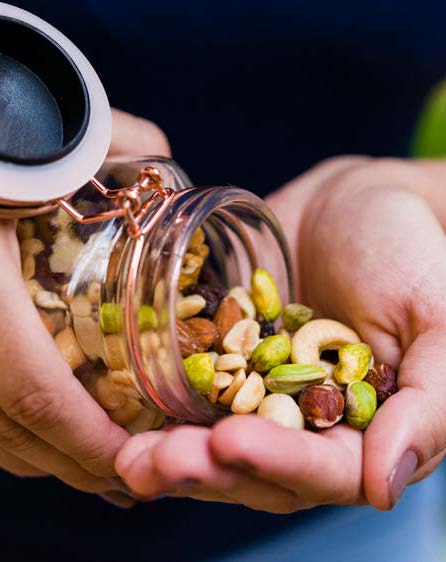
Try some of these calorie boosting ideas:
Fruits, vegetables, nuts, and other minimally processed foods are the best choices for snacks. If you purchase packaged products, read the ingredient labels, and select products with little or no added sugar. Whole fruits are preferred over juice, fruit snacks, or dried fruit because they are higher in fibre and lower in sugar per serving.
Powerful Bars Servings: 8 bars
Ingredients:
1 cup almonds
1 cup dried cranberries
1 cup pitted dates
1 tbsp unsweetened coconut fakes
1/4 cup mini dark chocolate chips
Instructions:
Combine all the ingredients in a blender or food processor. Pulse a few times to break everything up. Then blend continuously until the ingredients break down and clump together into a ball.
Using a spatula to scrape down the sides, turn the mixture onto a piece of wax paper or plastic wrap. Press into an even square and chill, wrapped, for at least an hour. Cut into the desired size of bars and wrap each bar in plastic wrap to store in the fridge.
Make sure to check the ingredient list on a package and look for known allergens or sensitivities. Also, use this list to identify “red light” ingredients in packaged foods, so you can avoid those products. There is some evidence that these “red light” ingredients are linked to ADHD-like neurologic-based behavioural problems and other behaviour problems. 22-24
| Ingredient Type | Avoid These | Better options |
| Food dyes (may be a combination of colours) | FD&C Blue 1, Blue 2, Green 3, Red 3, Red 40, Yellow 5, Yellow 6, Citrus Red, caramel colour | Naturally derived colours such as turmeric, paprika, and beet powder |
| Artificial sweeteners (often found in products labelled sugar-free or no sugar added) | Aspartame, Acesulfame Potassium, Neotame, Sucralose, Saccharin | Small amounts of natural coconut sugar, honey or molasses, maple syrup monk fruit, erythritol, xylitol, sorbitol, stevia leaf extract |
| Preservatives (used in deli meats, breads and baked products, snack foods, and most packaged foods) | Nitrates, sulphates, BHA (butylated hydroxy anisole), BHT (butylated hydroxytoluene) MSG (monosodium glutamate) DATEM, Sodium Benzoate | Uncured meats, alternative natural preservatives; tocopherols, vitamin E, rosemary, grapefruit seed extract, vitamin C, lemon juice |
| Anti-caking agents (added to dry foods like shredded cheese or protein powders) and texture enhancers (used in commercial bread baking) | Calcium silicate, DATEM (diacetyl tartaric acid esters of mono-and diglycerides) | Calcium carbonate and magnesium carbonate. |
Some children can also react to other naturally occurring food chemicals including amines, salicylates, and glutamate as well as wheat or dairy foods.25
There are different tests to identify food allergies and intolerances or sensitivities. Often, healthcare professionals do skin (scratch) tests to identify food allergens, such as peanuts and shellfish.
However, Dr. Leah Linder, a licensed Naturopathic Doctor, suggests: “Skin testing generally isn’t the best way to assess for food sensitivities. Many people have delayed immune reactions to food, which are not always caught on allergy skin tests.”
Instead, she recommends blood tests to measure delayed response reactions to foods. These tests measure specific proteins released by the immune system (IgA and IgG immunoglobulins) and can provide information about both short-term responses (24-48 hours with IgA) and longer responses (48-72 hrs with IgG). They’re best measured together because they provide better information about food sensitivities and intolerances (vs. allergies) and give you a clue as to the reason behind the sensitivity.
If you suspect food or ingredient allergies or sensitivities, contact your healthcare professional. They can test for these and help structure an elimination diet. However, eliminating highly processed foods with artificial additives is a great start for any child.21
Don’t hesitate to seek help from a qualified healthcare professional like a registered dietitian, a paediatrician, or a speech pathologist. They’re experts who are familiar with children’s feeding challenges.
A naturopathic or integrative medicine doctor can also help with advanced testing for food sensitivities and gut microbiome challenges. These experts can provide additional tools to make healthy eating easier for your child.
References available upon request